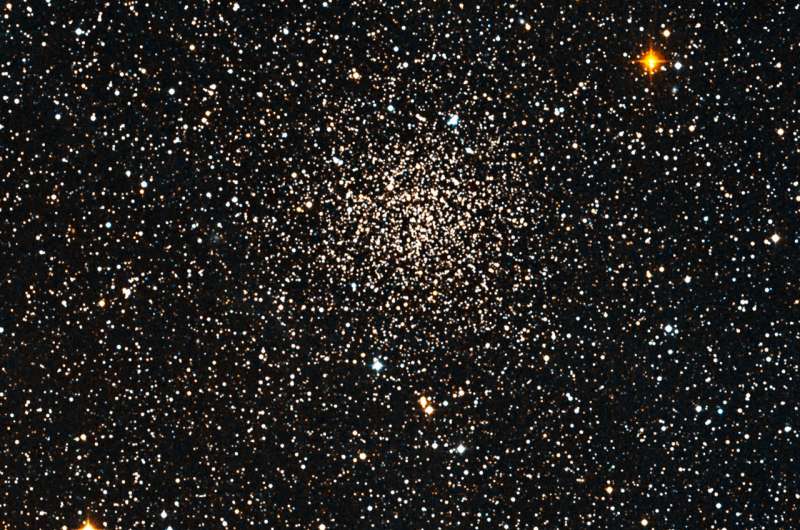This is a ground-based telescopic view of NGC 6791. Credit: NASA, ESA, DSS, and L. Bedin (STScI)
(Phys.org)—By conducting an orbital analysis, a team of astronomers led by Luis Martinez-Medina of the National Autonomous University of Mexico has uncovered new details about the origin and evolution of the old, metal-rich open cluster NGC 6791. The findings were presented Sept. 4 in a paper published on arXiv.org.
Located about 13,300 light years from the Earth in the Lyra constellation, NGC 6791 is one of the most studied open clusters. It has an estimated age of approximately 8 billion years and an iron to hydrogen abundance ratio that is more than twice that of our sun. This makes it one of the oldest and most metal-rich clusters in the Milky Way galaxy. With a mass of approximately 5,000 solar masses, it is also one of the most massive open clusters known to date.
Recently, Martinez-Medina's team has carried out studies of NGC 6791, performing an orbital analysis of this cluster within a more detailed model of our galaxy. The researchers focused on investigating possible locations for the formation of the studied cluster, hoping to learn more about its origin and evolution.
"In this work, we explore possible locations for the formation of NGC 6791, improving previous determinations by including, among other things, a more detailed model of the Milky Way galaxy, as well as a more rigorous criteria in the selection of the orbits," the astronomers wrote in the paper.
The team performed a comprehensive orbital study of NGC 6791 that included integrating a half-million orbits, representing the galaxy's stellar disc, for 8 billion years in order to find those with similar position, proper motion, and radial velocity to the current values of the studied open cluster.
Based on the conducted analysis, the authors hypothesize that NGC 6791 may have formed in the inner thin disc or in the bulge of the Milky Way galaxy. Afterwards, the galaxy may have been displaced by radial migration to its current orbit – about 26,200 light years from the galactic center. According to the study, the migration scenario would also explain the cluster's metal-rich composition, which is unusual for such old open clusters.
"There is a probability that an orbit could have suffered an outward radial migration that brought the cluster to its current galactocentric position and its distance from the plane. This scenario would explain its high metallicity, in spite of its old age," the paper reads.
The researchers emphasized that the birthplace and migration of NGC 6791 could be derived from its chemical composition, its mass loss, and its flat stellar mass function. When it comes to NGC 6791's initial mass, they assume that the cluster should originally have been over 10 times more massive than it is today.
"The birthplace and journeys of NGC 6791 are imprinted in its chemical composition, in its mass loss, and in its flat stellar mass function, further confirming its origin in the inner thin disc or in the bulge," the scientists concluded.
More information: New insights in the origin and evolution of the old, metal-rich open cluster NGC 6791, arXiv:1709.01079 [astro-ph.GA] arxiv.org/abs/1709.01079
Abstract
NGC 6791 is one of the most studied open clusters, it is massive (∼5000M⊙), located at the solar circle, old ( 8Gyr) and yet the most metal-rich cluster ([Fe/H]≃0.4) known in the Milky Way. By performing an orbital analysis within a Galactic model including spiral arms and a bar, we found that it is plausible that NGC 6791 formed in the inner thin disc or in the bulge, and later displaced by radial migration to its current orbit. We apply different tools to simulate NGC 6791, including direct N-body summation in time-varying potentials, to test its survivability when going through different Galactic environments. In order to survive the 8 Gyr journey moving on a migrating orbit, NGC 6791 must have been more massive, M0≥5×104M⊙, when formed. We find independent confirmation of this initial mass in the stellar mass function, which is observed to be flat; this can only be explained if the average tidal field strength experienced by the cluster is stronger than what it is at its current orbit. Therefore, the birth place and journeys of NGC 6791 are imprinted in its chemical composition, in its mass loss, and in its flat stellar mass function, supporting its origin in the inner thin disc or in the bulge.
© 2017 Phys.org























